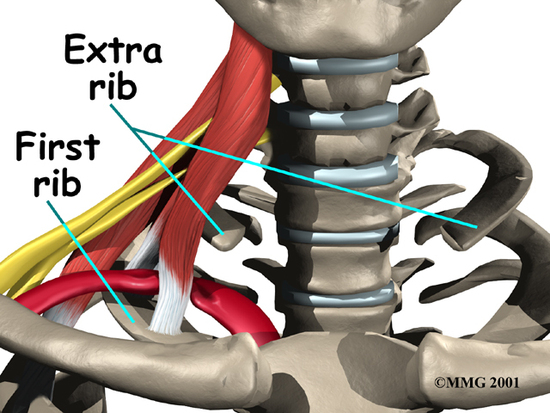Thoracic Outlet Syndrome (TOS) is a condition, which includes several upper extremity neurological and vascular symptoms. These symptoms are a result of compression of nerve, blood vessels, or both which run in the Thoracic Outlet. The anatomy of this outlet is compressed of several muscles in the neck region and the first rib under these muscles. This area is roughly between the base of the neck and the armpit. Any compression of the contents within the outlet can result in symptoms.
Symptoms of Thoracic Outlet Syndrome
Some of the symptoms associated with Thoracic Outlet Syndrome include:
- Diffuse aching pain or abnormal sensation, which extends from the neck area down the arm.
- Pins and Needles sensation or numbness down the arm.
- Numbness and pins and needles, which force the individual to wake at night.
- Intolerance to cold sensation.
- Loss of dexterity in the hand.
- Upper extremity limb may feel “tired.”
- Loss of muscle mass in the upper extremity.
What Causes Thoracic Outlet Syndrome Symptoms?
Compression of Neurovascular Bundle
Compression of nerves and blood vessels can occur because of a decrease in the space in which these structures must go through. This compression can occur because of the muscles in this area being too large, an abnormality in the rib structure, or a lesion within the area.
Poor Posture
Various postures tend to put increased pressure in the Thoracic Outlet. For example, forward head posture, rounded shoulders, and a rounded thoracic back can decrease the space by which the nerves and blood vessels can travel.
Pressure on Neural Tissue as a Result of Scar Tissue
Previous injuries can also play a role in the development of nerve tension within your Thoracic Outlet. By entrapping the nerve fibers, the nerves are unable to move properly during various activities.
Effects of Thoracic Syndrome on Activities of Daily Living
- Difficulty sleeping as a result of abnormal sensation
- Inability to carry certain items
- Difficulty driving, doing extended desk work and any over head movements
Thoracic Syndrome Treatment
Treatment may consist of improving the mobility of restricted nerve tissue and strengthening weak muscles. Also, increasing the flexibility of tight structures and educating the patient to eliminate provoking postures and activities.
The healthcare professionals at SEMI are trained in treatment techniques as well as therapeutic exercises to help you achieve your maximum physical potential. Schedule a consultation at our clinic today to learn more about treatments for Thoracic Syndrome and how we can help alleviate pain caused by your condition.
References
Kisner C., Colby L, (2002). Therapeutic Exercise: Foundations and Techniques. 4th Edition F.A. Davis Company, Philadelphia






